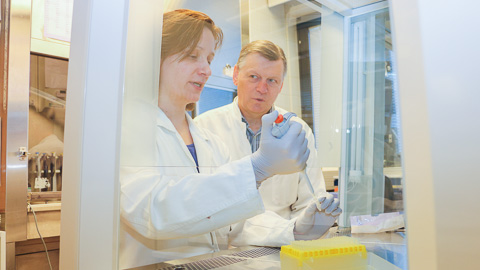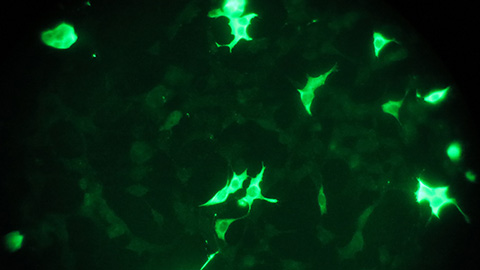Researchers Are Developing a Quick and Practical Test for Ebola
Those who who have contracted the Ebola virus could be diagnosed quickly with a test that is suitable for the conditions in Africa.

Laura Kakkola and Ilkka Julkunun have a Sierra Leonean gene sequence from July 2014 in their use, brought from a gene bank. On the basis of the gene sequences, the researcher have been able to produce viral proteins with the methods of genetic engineering.
Researchers of the University of Turku are participating in extensive research project supported by the Innovative Medicines Initiative (IMI) funding organisation and which includes 19 research groups from several European countries. The research groups in the Universities of Turku and Helsinki are developing a quick and simple virus test for the conditions in Africa.
– Ebola virus disease involves an acute onset of fever and it is difficult to diagnose at the beginning. Medical professionals should be able to recognise Ebola as soon as possible so that the patients could be directed to appropriate care and the spread of the disease prevented. In West Africa, patients with fever have been taken to the Ebola clinics in same ambulances and the disease could have spread from the patients with Ebola to the patients suffering from other diseases involving fever, says Professor of Virology Ilkka Julkunen.
The researchers' goal is to develop tests that could be used to diagnose Ebola virus infections quickly and reliably. The test results should also be easy to interpret. At the moment, the patients' blood samples often have to be sent for analysis from the Ebola clinics to central laboratories and frequently the results come back only the next day.
Quick Tests for the Typical Viruses in West Africa
The patients could be diagnosed faster with a quick test so that they could receive right treatment right away and new infections could be avoided with appropriate isolation.
One quick test has been developed in the United States for diagnosing the Ebola virus, but its use is only just being considered because of the possible incorrect positive results. Therefore the development of new, more accurate tests operating on different principles is very important.
– We are developing tests that recognise the typical viral infections in West Africa. This is a two-year research project but we are trying to make the test available for use as soon as possible. The first round of testing is meant to be carried out already during next summer or autumn, says Postdoctoral Research fellow in Virology Laura Kakkola.
Test Is Being Developed with the Help of Viral Proteins and Antibodies
Julkunen's research group produces viral proteins and their antibodies for the quick tests in their laboratory. With the antibodies, the group could create a so-called antigen test that reveals if the fever patient's blood contains Ebola virus or its proteins.
In addition, the researchers are developing an antibody test with the produced proteins, which could reveal whether the patient has had Ebola or if he or she is currently infected with the virus. The antibody tests are also suitable for examining the possible immune reaction created by the Ebola virus vaccinations and the resistance of the population to the disease.
– We have some of the Ebola virus genes in use and can make E. coli bacteria to produce viral proteins, among other things. Viral proteins can also be produced with different kinds of safe viral vectors used in biotechnology. If we manage to produce the viral proteins with E. coli bacteria or cell cultures, they still have to be cleansed of the foreign proteins or other structural components of the bacteria or cells, says Julkunen.
The gene sequences in the use of the researchers cannot create an infectious Ebola virus so their handling is safe. However, the testing of the effectiveness of the Ebola test requires a laboratory with the highest biosafety level, which the research group's partners in co-operation in the project have in other parts of Europe. According to the researchers, it is especially important to also study the the actual practicality of the quick tests in the outbreak areas in West Africa.

The viral protein of Ebola produced with the cell cultures can be seen as green in the microscopic image.
Prevention Measures Improved after the Outbreak of the Epidemic
The quick test is supposed to work so that the nurse takes a blood sample from the patient on a small disc containing antibodies that recognise the virus. In designing the test, the researchers take into consideration the heat, humidity and long distances in West Africa.
– It would be ideal if a nurse or another member of the health care staff could take the blood sample from the patient's fingertip with a puncture device that would minimise the risk of infection for the nursing staff. In the latest Ebola epidemic in West Africa, many heath care professionals contracted the disease during treatments and died. If many doctors and nurses are ill, the operation of the hospitals can collapse, states Kakkola.
The Ebola epidemic that started in 2014 has been significantly more wide-spread than the earlier ones, as altogether approximately 24,000 people have been infected in Guinea, Sierra Leone and Liberia. In the earlier epidemics, the disease has been contracted by a few hundred people at the most.
– The epidemic spread surprisingly widely quite quickly. There has been a risk that the Ebola virus could spread from Africa to other continents or locally outside West Africa, for example, to significant metropolises. Since the outbreak, especially the control and prevention measures have been invested in locally, so the possibilities for stopping the disease are considerably better than at the beginning of the epidemic, says Julkunen.
IMI funded the Ebola virus research with 215 million Euro, most of which was allocated to vaccination research. Three different research projects which are developing the diagnostics methods applicable in the conditions in Africa received over 10 million Euro from IMI. IMI is a public organisation of the European Commission and the pharmaceutical industry association EFPIA for the funding of research.
Text and photo: Jenni Valta
Translation: Mari Ratia